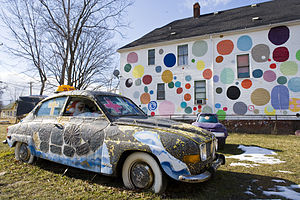The Mission District, commonly known as the Mission, is a neighborhood in San Francisco, California. One of the oldest neighborhoods in San Francisco, the Mission District's name is derived from Mission San Francisco de Asís, built in 1776 by the Spanish. The Mission is historically one of the most notable centers of the city's Chicano/Mexican-American community.

West Seattle is a conglomeration of neighborhoods in Seattle, Washington, United States. It comprises two of the thirteen districts, Delridge and Southwest, and encompasses all of Seattle west of the Duwamish River. It was incorporated as an independent town in 1902 before being annexed by Seattle five years later. Among the area's attractions are its saltwater beach parks along Elliott Bay and Puget Sound, including Alki Beach Park and Lincoln Park. The area is also known for its views of the Olympic Mountains to the west and the Cascade Range to the east. One-third of Seattle's green space and urban forest is located in West Seattle, much of it in the West Duwamish Greenbelt.
Heidelberg is a city of 150,000 in southwestern Germany.
College for Creative Studies (CCS) is a private art school in Detroit, Michigan. It enrolls more than 1,400 students and focuses on arts education. The college is also active in offering art education to children through its Community Arts Partnerships program and its Henry Ford Academy: School for Creative Studies.

The Cass Corridor is a neighborhood on the west end of Midtown Detroit. It includes the Cass Park Historic District, the Cass-Davenport Historic District and Old Chinatown. The corridor's main street, Cass Avenue, runs parallel with M-1, a main Detroit artery running north toward New Center. Though Cass runs from Congress Street, ending a few miles farther north at West Grand Boulevard, the Cass Corridor generally is defined as between Interstate 75 (I-75) at its southern end and Interstate 94 (I-94) to the north, and stretches from Woodward to the east and to the west: John C. Lodge north of Temple, and Grand River Avenue south of Temple.

The Arts District is a neighborhood on the eastern edge of Downtown Los Angeles, California in the United States. The city community planning boundaries are Alameda Street on the west which blends into Little Tokyo, First Street on the north, the Los Angeles River to the east, and Violet Street on the south. Largely composed of industrial buildings dating from the early 20th century, the area has recently been revitalized, and its street scene slowly developed in the early 21st century. New art galleries have increased recognition of the area amidst the downtown, which is known for its art museums.

Harvey Kurek Ovshinsky is an American writer, story consultant, media producer, and teacher, and has been described as "one of this country’s finest storytellers" by the Detroit News. The Metro Times called Ovshinsky's career chronicling life in Detroit during the 1960s, 70s, 80s, and 90s "a colorful and fantastic voyage, at times brave and visionary," spanning the universe of print, broadcast television and radio, and digital storytelling.
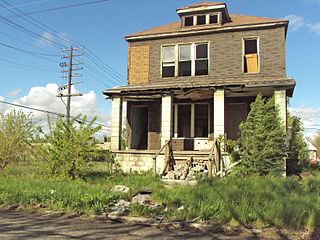
Shrinking cities or urban depopulation are dense cities that have experienced a notable population loss. Emigration is a common reason for city shrinkage. Since the infrastructure of such cities was built to support a larger population, its maintenance can become a serious concern. A related phenomenon is counterurbanization.
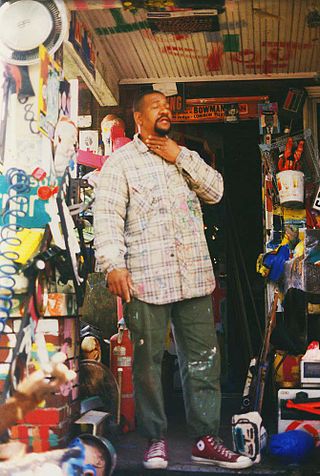
Tyree Guyton is an artist from Detroit, Michigan. He is married to Jenenne Whitfield and continues to live in Detroit. Before becoming an artist, Guyton worked as a firefighter and an autoworker and served in the U.S. Army. He studied art at Marygrove College, Wayne State University, and the Center for Creative Studies—now College for Creative Studies. Guyton counts his grandfather, Sam Mackey, and Detroit artist Charles McGee as his greatest influences.
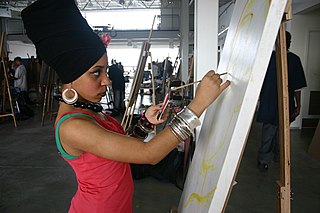
Artists For Humanity (AFH) is a non-profit youth arts and enterprise organization based at 100 West Second Street in South Boston, Massachusetts, United States.
Mitch Cope is an artist and art gallery curator from Detroit, Michigan.
Wade Guyton is an American post-conceptual artist who among other things makes digital paintings on canvas using scanners and digital inkjet technology.
Gaia is an American street artist who has received significant museum showings and critical recognition. Based in Baltimore, he has created large-scale murals worldwide to engage the community where he works in a dialogue by using historical and sociological references to these neighborhoods.Besides continuing to do commissions for private and corporate clients, Gaia is teaching two classes a semester- Drawing and Professional Developmant at his alma mater MICA.

Project Row Houses is a development in the Third Ward area of Houston, Texas. Project Row Houses includes a group of shotgun houses restored in the 1990s. Eight houses serve as studios for visiting artists. Those houses are art studios for art related to African-American themes. A row behind the art studio houses single mothers.
The Rudy Bruner Award for Urban Excellence (RBA) was established in 1986 by Cambridge, Massachusetts architect Simeon Bruner. The award is named after Simeon Bruner's late father, Rudy Bruner, founder of the Bruner Foundation. According to the Bruner Foundation, the RBA was created to increase understanding of the role of architecture in the urban environment and promote discussion of what constitutes urban excellence. The award seeks to identify and honor places, rather than people, that address economic and social concerns along with urban design.
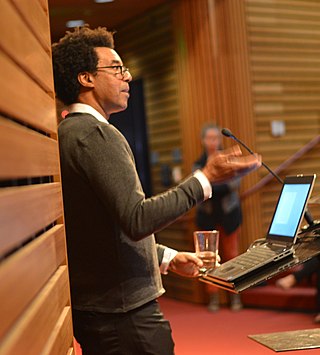
Rick Lowe is a Houston-based artist and community organizer, whose Project Row Houses is considered an important example of social-practice art. In 2014, he was among the 21 people awarded a MacArthur "genius" fellowship.

Midtown-Edmondson is a mixed-use neighborhood in western Baltimore City developed mostly between the 1880s and the 1910s. The neighborhood is mainly composed of residential rowhouses, with a mixed-used business district along Edmondson Avenue, and industrial warehouses and buildings dotted along the CSX railroads that bound its western edge.
Municipal disinvestment is a term in the United States which describes an urban planning process in which a city or town or other municipal entity decides to abandon or neglect an area. It can happen when a municipality is in a period of economic prosperity and sees that its poorest and most blighted communities are both the cheapest targets for revitalization as well as the areas with the greatest potential for improvement. It is when a city is facing urban decay and chooses to allocate fewer resources to the poorest communities or communities with less political power, and disenfranchised neighborhoods are slated for demolition, relocation, and eventual replacement. Disinvestment in urban and suburban communities tends to fall strongly along racial and class lines and may perpetuate the cycle of poverty exerted upon the space, since more affluent individuals with social mobility can more easily leave disenfranchised areas.

Tricia Ward is a Los Angeles–based artist whose work has included public and environmental art, sculpture, and social practice art. She emerged in the 1980s, when collaborations with underserved youth and urban groups that bridged art and social change began to gain institutional attention. Her work combines collaborative, interdisciplinary approaches that include physical transformations of derelict urban environments into "pocket parks," environmental remediation, cultural and educational programming, public policy and civic engagement.

